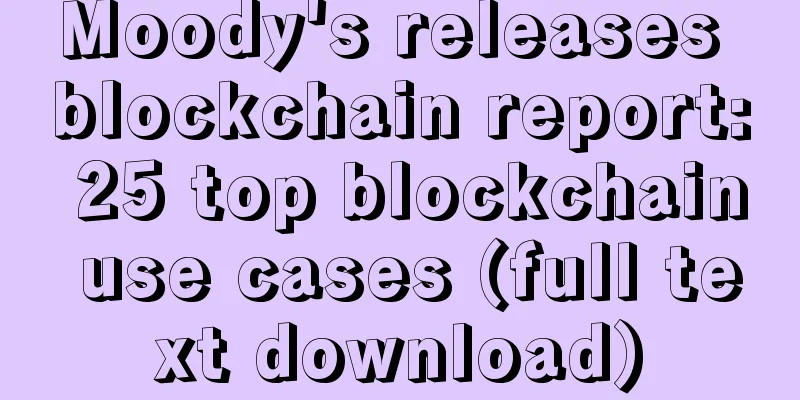Moody's releases blockchain report: 25 top blockchain use cases (full text download)

|
Moody's, Asia's leading credit rating agency, recently released "Credit Strategy - Blockchain Technology: Powerful and Cost-Effective Applications to Unlock Blockchain's Potential Credit Benefits" (full text download), which explores how blockchain technology has the potential to improve the efficiency of records and transactions in many different programs and industries. The best example is the capital market: coordinating independent ledgers and synchronizing all transactions on a blockchain - blockchain technology in the capital market can avoid all these troubles. The report also mentioned that this practice has not yet been popularized. Moody's Corporation is the parent company of MIS. Moody's has two reporting units: MIS and Moody's Analytics (MA). MIS, like many real companies, issues debt credit ratings, while MA develops a range of products and services that support financial analysis and risk management activities. Moody's has approximately 10,800 employees in 36 countries around the world and reported revenues of $3.48 billion in 2015. Global MIS's revenues were $2.33 billion, accounting for 67% of Moody's total revenues. MIS publishes thousands of pages of research reports every year. Its 2015 annual report says that the company's rating and analysis services cover more than 120 countries around the world, with credit ratings for nearly 11,000 companies and 20,000 public financial institutions, as well as 68,000 regular financial obligations. The company reported that Moody's search website received more than 259,000 visits, including 34,000 customer users. MIS continues to be ranked as the top credit rating agency in the United States. Institutional investors have named the company "the first-tier credit rating agency in the United States" for four consecutive years. Even the fixed income survey of the international authoritative financial magazine Asiamoney has called it "the first credit rating agency in Asia" for four consecutive years.
In recent years, major bloggers, forum posters and technology journalists have described use cases for Bitcoin technology. As far as use case suggestions go, there is an early example that is most worth learning from. The “Mega Blockchain List” published by investment firm Ledra Capital in March 2014 was initially an informal list of theoretical use cases for blockchain technology from Twitter. The list was closed after 84 use cases were implemented, covering seven categories. In June 2015, Santander InnoVentures, the venture capital arm of banking giant Santander, announced that it had identified 20-25 blockchain use cases that were already being used within the company, all of which were related to banking and finance. Unfortunately, these researchers did not publish their findings. Deutsche Bank has been looking at blockchain technology for more than two years. When the technology was only explored in the payment market, Edward Budd, managing director of Deutsche Bank's global financial transaction business, saw that blockchain technology had more potential in the securities field. In January, Budd said: "People see that blockchain has already been quite effective in the use case, and it is very dependent on the wholesale payment market. The question is why the market should turn to blockchain-based solutions? We think blockchain has more potential in securities collection."
Many institutions have conducted similar blockchain research and concluded that blockchain technology will first be used in capital markets. In the long run, they agree with Ledra's giant blockchain list, and there may be more applications outside the financial field. The IT information and outsourcing company released a white paper report in April: "Blockchain in Banking: A Cautious Approach". The report lists 6 financial and 13 non-financial blockchain application cases. All 19 cases were tested by one company. Many of the 25 use cases mentioned in Moody's recent report have been put into practice. Each case has a large definition paragraph and lists the research company and the development process of each case.
There are a lot of prominent examples on the list, like international payments and real estate, each of which includes processes that companies are working on, as well as less prominent use cases like tax records, energy credits, and medical records. The report also identified four basic approaches to blockchain development, but whether they are combined in practice is still unknown: "Investing in blockchain startups," "Cooperating with blockchain startups," "International projects supported by blockchain consulting and technology companies," and "Industrial cooperation between individual companies or between government and enterprises." The report said that the 120 companies on the list all fit into one of the above four categories and are continuing to develop. |
>>: Coinbase CEO: We misjudged the Ethereum hard fork, but it was still a success
Recommend
Four types of moles that can bring good luck
1. Mole on the top of the head In physiognomy, if...
Finger fortune telling: Ring finger and destiny prediction
The ring finger controls a person's social an...
What does a woman look like when she is kindhearted?
The Three Character Classic says that when a pers...
What is cinnabar nevus_the meaning of cinnabar nevus
Everyone has moles on their body. Moles are conge...
Senior UK financial adviser calls on government to ban cryptocurrency trading
Veteran financial advisor Neil Liversidge has cal...
Justin Sun, Chief Representative of Ripple Greater China, Talks about Bitcoin
Justin Sun mentioned in an interview with Phoenix...
How to diagnose illness through palmistry?
Everyone knows that a person's destiny can be ...
How to tell short life
The length of a person's life is closely rela...
Bitcoin price poised for surge as this key metric falls
Data shows that Bitcoin (BTC), priced at $11,400,...
Although UNI has asset value, Uniswap still has a long way to go to achieve decentralization
However, from the current perspective, the liquid...
What does a woman look like when she has a chaotic sex life?
A woman who is promiscuous must have a chaotic se...
Dubai faces concerns over testing blockchain technology
Rage Review : As an emerging technology, blockcha...
Where is the location of the wolf-hearted and dog-lung mole
Where is the location of the wolf-hearted and dog...
What diseases can be seen from the face?
Many doctors can observe whether a person is sick...
The facial features of those destined to make a fortune
The facial features of those destined to make a f...









